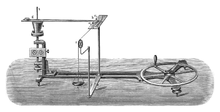Ivan Puluj
Ivan Pulyui | |
|---|---|
 | |
| Born | 2 February 1845 |
| Died | 31 January 1918 |
| Nationality | Ukrainian |
| Alma mater | University of Vienna University of Strasbourg |
| Known for | X rays |
| Scientific career | |
| Fields | Physicist |
| Institutions | Czech Technical University in Prague |
| Doctoral advisor | August Kundt |
Ivan Pavlovich Pulyui (Ukrainian: Іва́н Па́влович Пулю́й; German: Johann Puluj) (2 February 1845 – 31 January 1918) was a Ukrainian-born physicist, inventor and patriot who has been championed as an early developer of the use of X-rays for medical imaging. His contributions were largely neglected until the end of the 20th century.
Biography
Ivan Pulyui graduated with honors from Theological Faculty of the University of Vienna (1869), later also from the Department of Philosophy (1872). In 1876 Pulyui finished his doctorate on internal friction in gases at the University of Strasbourg under supervision of August Kundt. Pulyui taught at the Navy academy in Fiume (Rijeka, Croatia) (1874–1876), University of Vienna (1874–1884) and the German part of the Higher Technical School in Prague (1884–1916). He served as the rector of the Higher Technical School in Prague (German part) in 1888-1889. Pulyui also worked as a state adviser on electrical engineering for Bohemian and Moravian local governments.
In addition he completed a translation of the Bible into the Ukrainian language.[1][2]
Scientific contribution

Pulyui did heavy research into cathode rays, publishing several papers about it between 1880 und 1882. As a result of experiments into what he called cold light Pulyui developed the Pulyui lamp which was mass-produced for a period. This device was also some kind of primitive X-ray tube, but it was not until Wilhelm Röntgen discovered the X-rays and published his experiments, that Puluj recognized the potential of his own device. He was nevertheless among the first who worked with X-Rays and used them for medical diagnostics.[3]
Pulyui published his results in a scientific paper, Luminous Electrical Matter and the Fourth State of Matter in the Notes of the Austrian Imperial Academy of Sciences (1880–1883), but expressed his ideas in an obscure manner using obsolete terminology. Pulyui did gain some recognition when the work was translated and published as a book by the Royal Society in the UK.[4]
Pulyui made many other discoveries as well. He is particularly noted[citation needed] for inventing a device for determining the mechanical equivalent of heat that was exhibited at the Exposition Universelle, Paris, 1878. Pulyui also participated in opening of several power plants in Austria-Hungary.[5]
Quotes about Puluj
- "World history has never been just to certain individuals or certain nations. Small nations and their achievements are often neglected while the accomplishments of large nations are at times exaggerated."
- Slavko Bokshan, a Serbian scientist who worked in the same department as Pulyui and Roentgen
Honours
- Ukraine's Ternopil Ivan Pul'uj National Technical University is named after him.
- A stamp published on the occasion of Pulyui's 150th Birth Anniversary in 1995.
- Streets in Kiev, Lviv and other Ukrainian cities has the name of Ivan Pulyui.

Pulyui's publications
- Strahlende Elektrodenmaterie //Wiener Berichte I. - 1880. - 81. - S.864 -923; II. - 1881. - 83. - S.402-420; III. 1881. - 83. - S.693-708; IV. - 1882. - 85. - S.871-881.
- Strahlende Elektrodenmaterie und der sogenannte vierte Aggregatzustand' - Wien; Verlag Carl Gerold Sohn, 1883.
- Radiant Elektrode Matter and the so Called Fourth State. -London: Physical Memoirs, 1889. - Vol. l, Pt.2. - P.233-331.
- Über die Entstehung der Röntgenstrahlen und ihre photographische Wirkung// Wiener Berichte II Abt. 1896. - 105. - S.228-238.
Support of Ukrainian culture
Pulyui is also known for his contribution in promoting Ukrainian culture. He actively supported opening of a Ukrainian university in Lviv and published articles to support Ukrainian language. Together with P. Kulish and I. Nechuy-Levytsky he translated Gospels and Psalter into Ukrainian.[6] Being a professor Pulyui organized scholarships for Ukrainian students in Austria-Hungary.
Literature
- R. Gajda, R. Plazko: Johann Puluj: Rätsel des universalen Talents. EuroWelt-Verlag, Lwiw 2001, ISBN 966-7343-04-9
- S. Nahorniak, M. Medyukh: Physical-technical ideas of Ivan Pul'uj. Dschura, Ternopil 1999, ISBN 966-7497-34-8
References
- ^ http://www.tntu.edu.ua/?l=en&p=university/puluj
- ^ http://www.risu.org.ua/eng/religion.and.society/interview/article%3B15456/
- ^ Gaida, Roman (1997). "Ukrainian Physicist Contributes to the Discovery of X-Rays". Mayo Foundation for Medical Education and Research. Archived from the original on 2008-05-28. Retrieved 2008-04-06.
{{cite web}}: Unknown parameter|coauthors=ignored (|author=suggested) (help) - ^ Kulynyak, Danylo (9 July 2000). "Ivan Pului, the discoverer of X-rays". Ukrainian Weekly. 68 (23). Parsippany, NJ: Ukrainian National Association, Inc: 6.
- ^ Czech language biographical article in the journal of the Czech Technical University (2005, No 2, p. 39-40) mentions details and problems Pulyui met during the construction of early power plants in the Czech lands.
- ^ http://www.ukrreferat.com/index.php?referat=26888&pg=1
External links
- 1845 births
- 1918 deaths
- 19th-century Ukrainian people
- 19th-century Austrian people
- 20th-century Ukrainian people
- 20th-century Austrian people
- 19th-century scientists
- 19th-century physicists
- Ukrainian inventors
- Ukrainian physicists
- Ukrainian translators
- Translators of the Bible into Ukrainian
- Ukrainian Christians
- Ukrainian Austro-Hungarians
- Austrian inventors
- Austro-Hungarian inventors
- Austrian physicists
- Austrian people of Ukrainian descent
- Ukrainian expatriates in the Czech Republic
- Czech people of Ukrainian descent
- People from Husiatyn Raion
- Czech Technical University in Prague faculty
